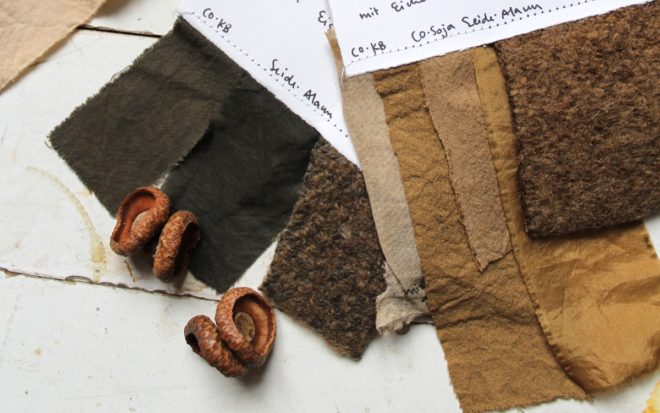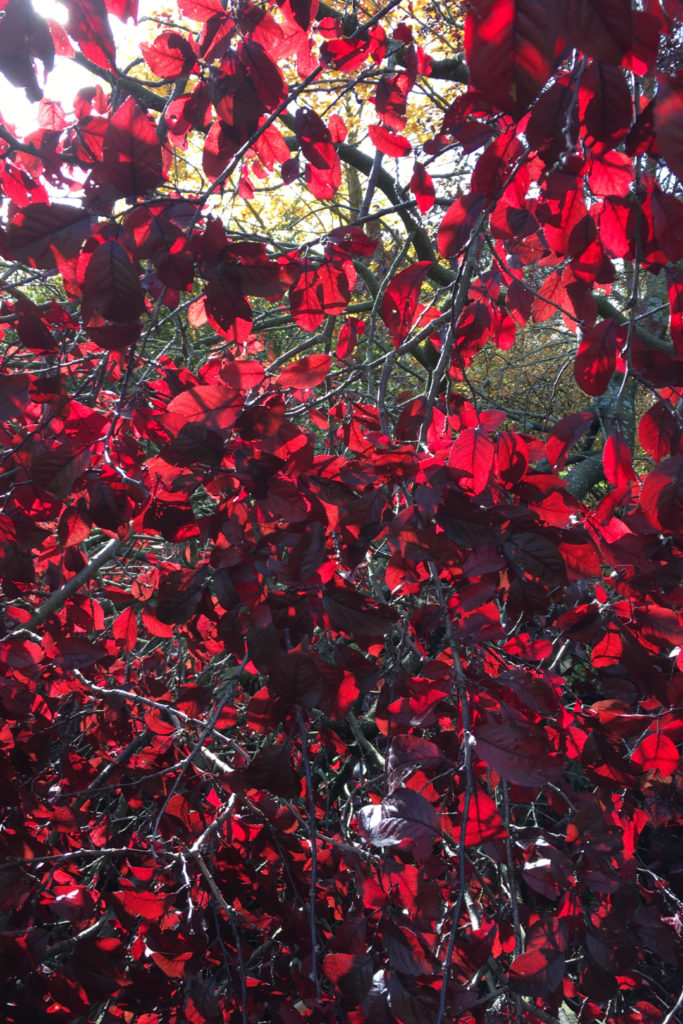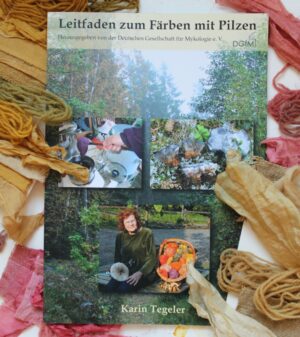Your basket is currently empty!

November dye plants: Dyeing with leaves
Autumn has arrived, the summer plants have faded and the trees are shedding their leaves. All beings are preparing for winter. We withdraw and enjoy the harvest of the previous months.
While summer is abundant and the time to forage, winter is for being cosy indoors, crafting and sure, also dye pots. But are you wondering if you could still find dye plants now?
That certainly depends on the weather in your region, but I would say yes. (Even though I have already collected and dried some things for the cold season over the summer.)
On my walk today, in early November, I found walnut leaves. Treasures can still be discovered now, especially when trees are growing a protected location.
I remember last year in November I also collected some cones from alder trees and caramel-coloured leaves from beech trees. If I collect something this time of year, it will mainly be what I can find on the ground, rather than picking from trees.
Dyeing with walnut leaves
Last year I prepared two dye baths to compare: one with walnut leaves that I collected green earlier in the year and then dried, and some that had already turned bright yellow on the tree. I wondered which would yield more dye, or if there'd even be a difference.
My conclusion was that the discoloured autumn leaves still dyed intensely. So there is still dyestuff to be found late in the year!
While the microseason of fresh green walnut hulls is already passed, fortunately, walnut leaves can be found for a longer period.


Purple leaf plum
In my favourite park I often walk by a fabulous purple leaf plum. Here I always find plenty of leaves on the ground after windy days, and sometimes only take a handful of leaves with me. There is a tree like that in your neighbourhood, but you only can gather a small amount of leaves at a time? Then try drying the leaves and keep gathering until you have enough for a small dye pot. Or try bundle dyeing or eco printing - then a small amount of leaves will be sufficient!
After a violent storm a few days ago, "my" blood plum unfortunately lost a large branch. So, for once, I was able to completely fill my small bag with the leaves. (If you want to go gather leaves after a storm, be careful. Branches could fall down later if the tree was damaged.)



Responsible foraging
Some trees, such as young beeches, keep their leaves on the tree in winter, while all other deciduous trees are bare. This probably protects the young trees throughout the winter. So we shouldn't defoliate them for our dye pot!
When gathering cones, acorns or other wild fruits and seeds, always pay attention to your surroundings. Is there only little of them in your area, or is it a year with only a small number of acorns, for example? In that case I'd leave the fruits for birds and other animals. They depend on these food sources, and in some years they can be sparse. Maybe they'll be plenty again the year after, and you can gather some for your dye pot with no harm.


Dyeing with discoloured autumn leaves
So I like to collect leaves from the ground, like I did with the blood plum... Either after a storm, when whole branches with still green leaves lie on the ground and I can simply pick them up from the paths on a walk. Or in autumn, when the trees shed their leaves.
I dyed beautiful tones not only with the discoloured autumn leaves of the walnut, but also with leaves of oak and beech that had turned reddish brown.
If you collect leaves from the ground, however, they should still be as fresh and intact as possible, not mushy or already very fragile. Leaves that have been lying on the ground for a long time or soaked in puddles for days, I would no longer spend time on to collect. If they are still in good condition (the leaf structure still feels like leaves on a tree) then experimenting with them is should be worthwhile.


Do you have any ideas on the topic? Or do you prefer not to collect anything in autumn?

Interessieren dich außer den Pflanzen auch Färbepilze? Dann ist dieses Buch vielleicht genau das Richtige:
-
 Leitfaden Färben mit Pilzen18,00€ inkl. MwSt.
Leitfaden Färben mit Pilzen18,00€ inkl. MwSt.incl. VAT
Comments
4 responses to “November dye plants: Dyeing with leaves”
-
Ich habe letzten Herbst frisch gefallene Ahornblätter gesammelt, getrochnet und sie dann erstmsl vergessen… Im Frühjahr hab ich dann damit gefärbt und wunderbare satte Senftöne erhalten. Das werde ich auf jedenfall wiederholen, es hat sich sehr gelohnt!
-
Danke für den Tipp! Mit Ahornblättern habe ich mal früh im Jahr gefärbt, nachdem ein Ast vom Sturm runterkam. Da war die Farbe eher mäßig interessant, aber die Blätter auch noch sehr jung. Dann probier ich es im Herbst wohl nochmal.
-
-
Ich habe heuer mit den roten Blättern des rosa blühenden Hartriegel Wolle gefärbt. Es ergaben sich herrliche Farben im „Bernstein-Bereich“. Zwei Stränge habe ich mit „Eisenwasser“ nachbehandelt- herauskristallisiert hat sich ein graphitgrau und hellgrau.
-
Hallo Waltraud,
danke für den Tipp! Damit habe ich bisher nie gefärbt, und nach einer kurzen Recherche denke ich, den kenne ich aus meiner Umgebung auch gar nicht. Aber ich werde mal die Augen offen halten.
-
Leave a Reply